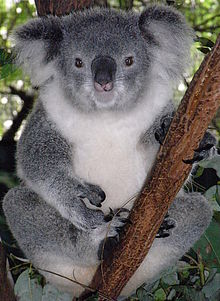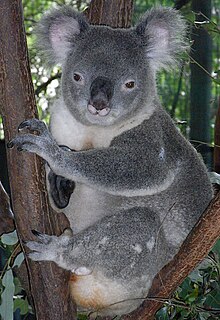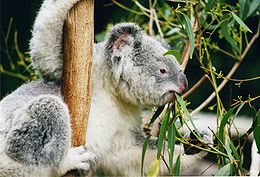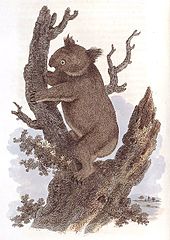Koala bear
| Koala bear | ||||||||||||
|---|---|---|---|---|---|---|---|---|---|---|---|---|
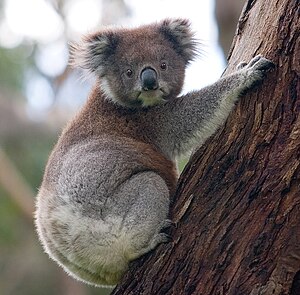
Koala ( Phascolarctos cinereus ) |
||||||||||||
| Systematics | ||||||||||||
|
||||||||||||
| Scientific name of the family | ||||||||||||
| Phascolarctidae | ||||||||||||
| Owen , 1839 | ||||||||||||
| Scientific name of the genus | ||||||||||||
| Phascolarctos | ||||||||||||
| de Blainville , 1816 | ||||||||||||
| Scientific name of the species | ||||||||||||
| Phascolarctos cinereus | ||||||||||||
| ( Goldfuss , 1817) |
The koala ( Phascolarctos cinereus ) is an arboreal marsupial mammal in Australia . It was first described as Lipurus cinereus by the zoologist Georg August Goldfuß in 1817 . Along with the kangaroo, the koala is the most widespread symbol of Australia.
Appearance
The koala becomes 61 to 85 cm tall and weighs between 4 and 14 kg. The height and proportions of an adult animal depend on age, sex, diet and region. Koalas living in cooler climates are generally larger and have darker and denser fur than those of animals in warmer regions. Despite these adjustments, there are also exceptions. In fertile Victoria , adult male koalas can weigh up to 14 kg, females up to 11 kg. The average weight of the animals living north is lower: males reach 12 kg, females 8 kg. The koalas in low-precipitation Queensland are generally smaller, the average weight of the males is 8 kg, that of the females 6 kg.
The koala has a brownish-silver-gray, woolly fur, on which rainwater rolls off like the plumage of a duck with regular care , and two gripping hands with pointed, sharp claws , each with two thumbs and three opposite fingers, which are good for climbing and grasping branches suitable. The fingertips have papillary ridges that are extremely similar to those of humans . Their feet have a clawless thumb, the second and third toes are fused together so that the fused claws can be used to remove ticks , which they often suffer from. Characteristic features are a protruding, dark nose and large ears , from which you can see that smelling and hearing play an important role in their lives. The koala has a large head in relation to its body, the brain mass of which is relatively small. The fur of wild koalas is more weathered than that of human koalas.
Males differ from females by their scrotum and scent glands on the chest , which are characterized by their pouch on the belly side. As with the wombats (in contrast to the kangaroos ), the pouch is equipped with a downward-facing opening. Adult males can be up to 50% larger than adult females and have a slightly different head shape in addition to a hooked curve of the nose. Due to the special process of pregnancy, childbirth and rearing of cubs, koalas do not have a navel.
Sensory performances
As nocturnal animals, koalas have good hearing , but eyesight is rather moderate. The koala's large nose is extremely sensitive. It informs the koala of everything related to survival, territories, and mating. This includes the selection of suitable eucalyptus leaves that should not contain too much toxins, the timely determination that enemies are nearby, the recognition and determination of foreign odor markings according to gender and smelling the mother or child.
distribution
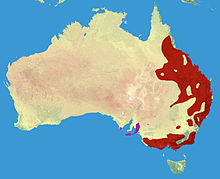
Koalas were originally widespread in Australia, but were hunted for their fur and thus wiped out in many areas. Some of them could be resettled. One reserve is, for example, Kangaroo Island off Adelaide, where the koala was not originally native. Larger populations can be found along the Australian east coast in Queensland , New South Wales and Victoria and in areas in the hinterland where there are enough forage trees. The total population is estimated at 45,000–80,000 animals. There are no koalas in the state of Tasmania .
Subspecies
Traditionally, three subspecies of the koala are distinguished according to morphological aspects. The typical subspecies Phascolarctos cinereus cinereus is medium-sized and has a relatively dense fur, which appears mixed-gray due to the ash-gray tips. The type specimen of this form comes from the Nepean River area in New South Wales . The northern subspecies Phascolarctos cinereus adustus , which was described in 1923 using a specimen from Queensland, is significantly smaller and has a much shorter silver-gray fur. The southern subspecies Phascolarctos cinereus victor , on the other hand, is significantly larger and characterized by a more cinnamon-colored fur.
habitat
Koala populations can only spread in habitats that meet certain conditions. A suitable habitat contains trees preferred by koalas (mainly eucalyptus species, but also some others) in certain societies on suitable soils as well as sufficient rainfall. Another criterion is that other koalas must live nearby. Such habitats are light eucalyptus forests, in which other tree species are only sporadically represented.
Often, however, due to deforestation, koalas live in a steppe landscape with rather scattered trees, which in the worst case may be near a road. In this case, the territories are larger, as this is the only way to ensure that they contain enough forage trees. They can also be found on green spaces with eucalyptus trees in cities, which, however, are not suitable habitats for them. Such animals typically fall prey to cars, dogs , swimming pools, and other man-made hazards.
The size of koala populations is directly dependent on the size of the habitat and the number of nutritionally relevant eucalyptus species growing in it and their vegetation density. If a habitat is reduced in size or cut up, the ecological load-bearing capacity of the habitat is reduced proportionally to its area. Due to clearing or forest fires, many of the Koalas' former distribution areas are now below the minimum size necessary for a stable population.
Way of life
Koalas are tree dwellers and mostly nocturnal. They are reluctant to be on the ground and then move forward on all fours. In order to save energy, they sleep up to 20 hours a day and thus even longer than the sloths , which (at least in captivity) sleep around 16 hours a day. Their natural enemies are dingoes , great owls , eagles , monitor lizards and pythons . In addition, dry seasons and especially bush fires can be dangerous for them. Human habitation creates additional hazards such as cars, stray dogs, increased fire risk, insecticides and swimming pools; If a road is built through the middle of a territory, the koala remains in the half in which it is currently located. The habitat is also restricted by clearing, drainage measures and the construction of fences.
nutrition
Koalas feed almost exclusively on leaves and bark as well as fruits of certain types of eucalyptus. In the whole of Australia they only use around 70 of the over 500 known eucalyptus species, locally only 5–10 species. As a rule, no more than two or three eucalyptus varieties are used for food consumption within a limited area (primary food trees). A variety of other trees, including some non-eucalyptus species, are occasionally used for food or other purposes (e.g. resting, sleeping). Occasionally ingested soil provides additional minerals.
An adult koala needs around 200 to 400 grams of leaves per day. When it comes to food, koalas are necessarily extremely picky, because eucalyptus contains toxins that the koala can tolerate to a certain extent, but too high concentrations are also poisonous for them. First they stretch out an arm and carefully pick a few selected leaves, preferably older ones, in which the toxins are no longer so concentrated. Then they sniff them carefully before taking a bite. Finally they are chewed to a pulp and swallowed. Koalas drink extremely rarely. They cover their water needs mainly through the very water-rich eucalyptus leaves. Dew and raindrops are of lesser importance. In dry seasons, however, they go to water points despite all the dangers. In this context it is also interesting that the name "Koala" comes from an Aboriginal language and means something like "without water" or "without drinking". (See also the “Aboriginal” section below.)
The teeth of the koalas ( I 3/1, C 1/0, P 1/1, M 4/4 × 2 = 30) are well adapted to the eucalyptus diet. The animals pick the leaves with their upper and lower incisors. A gap between the incisors and molars makes it possible to use the tongue to effectively push the leaf material back and forth without biting. The molars are shaped to cut and tear the leaves rather than just crush them. In this way, the teeth remove moisture from the leaves and destroy the cell walls , which makes digestion easier.
Koalas extract energy from the eucalyptus in the form of sugars, starches, fats and proteins. In a relatively long digestive process, all usable nutrients and water are removed. Corresponding to the indigestible, low-energy and even toxic plant food, the koala's appendix is unusually long (up to 2.5 m). There, bacteria help to work up the cell walls and allow a kind of fermentation to take place. In addition, a very slow metabolism enables the eucalyptus to be stored for a long time in which the maximum amount of energy is withdrawn from it. At the same time, the slow metabolism results in a lower energy consumption, so that it is lower than that of other herbivores.
Life in trees
Koalas spend most of their lives on eucalyptus trees. These tree dwellers are stout climbers with lean, muscular bodies. They have short, stocky bodies but relatively long limbs. Your hands, feet and claws are suitable for packing branches, for holding onto branches and for balancing. When in danger, koalas instinctively seek shelter in the branches of a tree. In human settlements, they climb walls, fences, light poles, and street signs.
If koalas want to climb a tree, they jump up from the ground and dig their claws into the bark. Then they climb up in flowing movements with both arms and legs at the same time. Koalas always climb up and down trunks with their heads up and down. The descent is usually more deliberate. Only one leg is moved here at a time.
Koalas regularly come down to the ground to change trees. Most of the dangers lurk here. They walk by first putting the right front foot, then the left rear foot, then the left front foot and finally the right rear foot forward. When running, they put both front and back legs at the same time.
Some koalas stay on the ground longer than others. This behavior depends on the size of their territories and on the distances between the trees. In the vicinity of human settlements, larger distances often have to be covered on the ground than in undisturbed surroundings.
On their safe and comfortable living trees, koalas display a variety of resting postures, depending on the nature of the forks of branches, weather conditions and the time of day. Since the weather in the Australian bush changes with the time of day, the koalas are always looking for new places in the tree, sometimes in the sun, sometimes in the shade, sometimes in the cooling wind, sometimes in the slipstream or sheltered from the rain.
Koalas can comfortably rest on a branch for hours. They wedge themselves between forks of branches so as not to fall from this safe sleeping place. Their particularly dense fur on the rear provides a soft surface for the hard and angled branches. In cold, wet and windy weather, they tend to curl up like a ball in order to reduce their surface and give off as little heat as possible. Then the water runs off the koala's back like a duck's back . On hot, dry or warm and humid days, they prefer an open position, so that their light and long pleura can reflect the heat and flutter a little in the wind and thus cool.
Social behavior
Koala populations have an intricate system of communication and organization that ensures social cohesion. Although they are loners outside of the mating season , they subordinate themselves to a social hierarchy in stable populations by establishing overlapping territories and behaving according to their position. If this order is destabilized, the group suffers.
Territories
Each koala establishes its own territory. Its size depends on several factors such as the quality of the habitat, gender, age, social status and the carrying capacity of the habitat.
The size of the area ensures a sufficient number of suitable trees in a socially stable population to offer the koala enough food and protection. Apart from disasters and disturbances of the habitat, it can remain true to its territory for a lifetime. In order to eat, seek protection or maintain social contacts, koalas regularly change trees within their territory. They also set scent marks to delimit their area.
In a stable population, the territories of the neighbors overlap. Males prefer territories that overlap with one or more territories of females. If males overlap, contact is avoided. The territory of a female overlaps with territories of both sexes. Before the boys migrate, they consider their mother's territory to be their own. Territories of male koalas are generally larger than that of females.
The border trees of a koala area, recognizable by the large number of scratches and heaped droppings, are regularly visited. Some of them also serve as meeting places, which play a decisive role in the stability of the population. While male koalas mark their territories with the scent of their mammary glands, females use the scent of their urine.
Due to self-restraint, not every food tree is used within a district. These unused food trees are defended just like the used ones, so that they are inaccessible to other koalas. Due to this behavior, the population is kept in equilibrium, since uncontrolled reproduction is avoided, which would pollute the habitat too much. Because of this, the young have to leave their mothers. If they stayed, they would be food competitors of their mother or other animals. Young koalas need to settle on the fringes of a community.
If a koala dies, its territory is taken over by a conspecific, whereby the boundaries remain almost the same. Young koalas often roam the edge of a colony for months before establishing permanent territory. These then often take over orphaned territories. In the wild, territorial fights take place, especially during the mating season.
Emigration and expansion
Young koalas are forced to leave their mother's territory some time after weaning. This usually happens at 18 months of age. Since not all females reproduce annually, it can only happen after two or even three years. Migrating koalas look for a habitat that is both vacant and close to other koalas.
Territorial koalas are sometimes forced to travel long distances to find a suitable area. These migrations ensure genetic exchange between neighboring reproductive groups and thus ensure the genetic diversity of populations.
Migration and spread are now hindered by human interference in many koala-populated areas. Available habitats are often restricted or fragmented, so that young koalas cannot find suitable territories. They either perish from it or they have to wander around all the time. However, this can lead to overexploitation of food sources, the death of trees and the decline of the population.
understanding
Koalas have a number of vocalizations that allow them to communicate over relatively long distances. Both female and male koalas use the fear cry. This sounds like a scary cry from an infant. It is expelled under stress and is often accompanied by tremors.
Males give a deep, grunted bark when announcing both their presence and social status. It often sounds like a distant rumble, like a motorcycle starting or like a grunting pig. With this barking out of their dominant position, the males save themselves the energy expenditure of a fight. There is a lot of barking during the breeding season to allow other animals to pinpoint the exact position of the caller.
Females do not bark as often as males. But their calls also serve to communicate aggression and sexual mood. With their boys, mothers exchange gentle clicking and squeaking noises, but also slight grunt tones that express discomfort and anger. Sometimes a low hum or murmur can be heard.
Diseases
Koalas can easily catch various diseases and ailments because of their poor immune system . These include genitourinary diseases, respiratory and digestive tract diseases, stomach ulcers, cancer, dehydration and muscle wasting. Koalas are particularly sensitive to habitat and physical stress . Outwardly, stress in koalas can be demonstrated by wiggling their ears or even hiccups . Because of the increased activity and stress, they are particularly susceptible to disease during the reproductive period. Chlamydia infections then often occur . These occur more frequently due to infection with the koala retrovirus, which, like HIV in humans, massively weakens the immune system. Only sick koalas show a wet coat after a rain shower because they no longer have enough energy to care for it regularly, so that the pearly effect is lost. They also often have an unusually high number of ticks . In old koalas, wear and tear on their teeth can lead to death, as they can then no longer chew the leaves and consequently starve to death.
Reproduction
Koalas reach sexual maturity at around two years of age. However, successful copulations usually only take place one to two years later. The females usually reproduce earlier for the first time, as the older dominant males keep the younger ones away from the action. It is controversial whether the males go in search of females or vice versa. Perhaps this depends on the animal's status in the social hierarchy. The dominant males must maintain their position vis-à-vis other males and overlook their females. Nevertheless, it happens that a female in heat goes in search of a dominant male.
Mating and fertilization
During the breeding season, koalas are more active than usual. During this time, male koalas often emit far-reaching, hoarse barks. This sound is used to mark the territory, but also to provide information for the females ready to mate. In the case of koalas, the females basically determine when the mating takes place. Usually the female koala is still looking after a young from the previous year. A new koala baby can only be raised when the previous young animal has been weaned. This usually takes about twelve months. Depending on the region, the time of mating can stretch from October to April. Almost adult young animals are mostly driven from the territories of their mothers, so that they have to set up their own territories.
The males are very aggressive during the mating season and often injure each other with their sharp claws. Males mate with all reachable females during the mating season, this is usually associated with scratching and biting. Since the seeds of the predecessor are largely flushed out when mating, dominant males also try to mate females that have already been mated by another male.
Pregnancy, parturition and rearing of young
The gestation period is 35 days. At birth, the baby crawls independently from the birth canal into the pouch. It then weighs less than a gram and is about 2 cm long, blind and naked. In the bag, a strong sphincter prevents the completely enveloped boy from falling out. Usually only one young is born in summer, which matures in the pouch for six to seven months and is suckled. After about 22 weeks, it opens its eyes and begins to look out of the pouch. When they are 22 to 30 weeks old, they are given a supplement called “cardboard”, which their mother produces in addition to the milk. Cardboard is a special type of excrement that makes it easier for the boy to switch from milk to leaf food, a decisive change, and is increasingly becoming the main food of the boy, who leaves the bag more frequently as he grows and when eating on the mother's stomach lies. During this time it learns to grab leaves with its hands and carefully sniff them before eating them. Even so, the youngster continues to take breast milk until it is one year old. Due to the size of the young, the mother's teat is now elongated so that it protrudes from the opening of the bag. With the start of leaf nutrition, the young grow much faster and their physique becomes more compact. The mother now carries the baby around on her back, but still seeks protection in the mother's pouch. If it is bigger, it makes its first excursions around the mother.
After around twelve months, the young will be independent enough that the mother can become pregnant again. If there is a new offspring, the mother no longer allows her previous year's cub to suckle and ride, but still tolerates it in her vicinity until the younger one makes its first excursions. Usually the young are driven away by the mother around the age of 18 months. If the mother is not pregnant again, however, the young can enjoy maternal protection for up to three years. After being driven out, it emigrates and establishes its own territory.
Wild males generally have a lower life expectancy at an average of ten years than females at 15 because they often injure themselves in fighting, usually continue to migrate, and often live in moderate habitats. Koalas in the wild generally live shorter than in captivity (females up to 19 years of age). Koalas live particularly briefly in urban suburbs or near a highway. Here the mean life expectancy of a male is two or three years.
Systematics and evolution
|
Internal systematics of the Phascolarctidae family according to Black and Archer 1997
|
Koalas belong within the marsupial order Diprotodontia to the subordination of the Vombatoidea , which also includes the wombats (for more details see the systematics of Diprotodontia ). The koalas are the only living representatives of the Phascolarctidae family .
The earliest fossils in the koala family are around 25 million years old. However, they are rare and you usually only find individual teeth and bones. It is assumed that the representatives of all five fossil genera known to date ( Koobor , Madakoala , Perikoala , Nimiokoala and Litokoala ) were tree-dwelling leaf-eaters who ate rather soft vegetable food. The high level of specialization in hard eucalyptus leaves only took place with the formation of the genus Phascolarctos and the emergence of today's koalas ( Phascolarctos cinereus ).
One explanation for the striking rarity of fossil finds would be that the early koalas themselves were rare. They probably specialized in the leaves of the precursors of today's eucalyptus trees, which were only found scattered in the then rainforests of Australia . The land later dried up as a result of an ice age and the continent's slow approach to the equator. As a result, the eucalyptus spread and increasingly dominated the open forest areas of Australia. Now the koalas could develop better. It is believed that the eucalyptus and koalas evolved together over millions of years, and that the koalas were more common and widespread than their ancestors in Aboriginal times .
Koalas and humans
Human relationships with koalas have fluctuated widely over the years. The natives were no more or less interested in the koala than other animals around them. The early settlers of Australia saw it as a curiosity and soon began to hunt it for its fur. Today it is internationally recognized as a symbol of Australia.
Aboriginal
The Aborigines hunted koalas for their meat and fur. There have been some oral Dreamtime legends about the koala that explain its physical characteristics. It was a commonly used totem symbol . Whoever had the koala as a totem was not allowed to kill it. The koala was considered part of dreamtime creation.
The word "Koala" comes from the now almost extinct language of the Darug Aborigines from the area around Sydney. It was called gula , in English spelling koola , and is usually translated as “don't drink”. A typing error resulted in the shape "Koala". Other Aboriginal names for the animal are: Kallwein, Kuhlewong, Kolo, Kola, Kuhla, Kaola, Karbor, Burabie, and Goribun.
After the arrival of the Europeans
Koalas were seen by the European settlers as a peculiarity of the Australian continent. After learning how easily Aboriginal koalas could catch koalas soon after their arrival, Europeans hunted down hundreds of thousands. Koala furs became a popular item on the world market.
In 1919 the Australian government decided to hunt koalas (and tree kangaroos ) for six months , which killed one million koalas. However, this massive shooting led to public protests, which is why the koalas were placed under hunting protection again that same year. However, the koala was still illegally stalked all year round. By 1924 the koalas were exterminated in South Australia, massively decimated in New South Wales and in Victoria the population was estimated at 500 animals. With that, the fur trade shifted to Queensland .
In August 1927 the government released the koala hunt in the hope of a vote. An estimated 800,000 koalas were killed in the short span of 31 days, causing a colossal public riot. At that time, 80% of their former habitats were destroyed. The willingness now to support the koalas paved the way for the koalas to be protected in the late 1930s. The koala was declared a protected species across Australia in 1937.
Today's meaning
The koala is a high-profile animal these days, a symbol of efforts to protect Australia's flora and fauna. Due to its cute appearance, it has gained great popularity on all continents . In addition to his fluffy ears and big nose, his peaceful nature and his resemblance to the teddy bear contribute to this.
While the koala was only considered to be a fur bearer in the early period of Australian settlement, at the beginning of the 20th century in times of nationalism it became a recognized symbol of Australia. Within a few years, koala figures such as Blinky Bill and Bunyip Bluegum developed . These were endowed with human characteristics, such as a little disrespect, with clear moral concepts . He has also been described as an unbuttoned, fun character. Characters like Blinky Bill should point out weaknesses and contradictions of individual persons. The koala has since been considered the personification of the Australian character. Many koala drawings and caricatures were used to depict very general characteristics such as national pride, motherhood, courage and humility. This continues to this day.
Today's threat
According to a WWF analysis, 80 percent of koalas have disappeared in some regions of Australia since the 1990s.
In the past, the soft, durable pelts of the koalas were in great demand, so that they were severely decimated by hunting. Despite being under protection since 1937, around 4,000 urban koalas die each year from human causes. There are three to four animals for every recorded koala who have had an accident and die unnoticed as a result of accidents.
The following table shows the threat to koalas in the Australian states:
| state | Official status (1994) | Actual hazard |
|---|---|---|
| Queensland | Frequently | Bit by bit destruction of habitats, no legal protection, factual status: rare and threatened |
| New South Wales | Rare and threatened | Isolated island-like colonies, progressive destruction of habitats, koala initiatives |
| Victoria | Without | So-called “overpopulation problems”, populations declining in the rest of the area |
| South Australia | Rare and threatened | Small populations restricted to Kangaroo Island and the Adelaide Hills |
The relocation of koalas to Kangaroo Island has led to such a high increase that the eucalyptus trees and thus a number of other animals are now threatened. This is due to their eating habits: Koalas move only a little and therefore eat the branches on which they sit downright bare. A resettlement program failed due to a lack of consideration for the needs of the koala population, which is why koalas on Kangaroo Island are even released for shooting again.
At a certain point, koala populations can no longer sustain themselves. Each population is adapted to its habitat and each area is unique. Areas designated for koala populations must be suitable and large enough. However, this is not taken into account in many relocation attempts. Another problem is that around 80% of koalas live on private land. This is especially true on the east coast of Australia. Deforestation in particular leads to a decline in habitats for koalas. If no effective protective measures are taken, according to calculations by the “Australian Koala Foundation”, the koalas will be critically endangered in 2080 and therefore threatened with extinction. In an IUCN report from December 2009 for the UN Climate Change Conference in Copenhagen , it is also assumed that the koala is one of the animal species most threatened by global warming .
There were major losses in the 2019/2020 bush fires in Australia : Among other things, it is estimated that around 33,000 of the approximately 80,000 koalas living in Australia had died by mid-January. The individual populations in Australia were affected differently. In addition to the direct deaths from the fires, indirect effects of the fires such as car accidents, attacks by pets and the loss of fodder trees also have a negative impact on the population figures.
Keeping in captivity
The first captive koalas were displayed to the public in Koala Park in Sydney around 1920 . Since then, they have been shown more and more frequently in exhibition enclosures.
Koalas are rarely shown in zoological gardens outside of Australia , which is mainly due to the difficulty of providing enough suitable eucalyptus for the animals. For the first time in Germany , Tierpark Berlin showed koalas in 1994, before the animals were transferred to the Duisburg Zoo , where they are now regularly bred. Since November 2013, two male koalas have lived in the Prof. Brandes House of the Dresden Zoo . Both animals were born in the Duisburg Zoo in 2011 and 2012 and were successfully relocated after obtaining all permits and training from the animal keepers. In Vienna Schonbrunn Zoo koalas are also kept. The Leipzig Zoo has a male koala named OOBI-Ooobi from a zoo in since April 2016 Belgium adopted. He lives in the former animal monkey house , which has been lavishly prepared for this purpose and is now used as a koala house. Koalas have also been living in Zurich Zoo since March 2018 .
In enclosures, koalas cannot show any pronounced migratory behavior, as they live there under closer conditions and much higher density than in the wild. Nevertheless, even here they still show certain social behavior of wild animals. This includes the territorial behavior and the ranking of the males.
literature
- Ann Sharp: Koalas. The teddy bears from the eucalyptus forest. Australian Koala Foundation. BLV Verlagsgesellschaft, Munich / Vienna / Zurich 1995, ISBN 3-405-14845-6 .
- Ann Sharp: The Koala Book. Australian Koala Foundation. Pelican Publishing, Gretna La 1995, ISBN 1-56554-160-X . (English)
- L. Cronin: Koala, Australia's Endearing Marsupial. Reed Books, Frenchs Forest NSW 1987, ISBN 0-7301-0158-4 .
- AK Lee, RW Martin: The Koala. A natural history. New South Wales University, Kensington 1988, ISBN 0-86840-354-7 .
- AK Lee, KA Handasyde, GD Sanson: Biology of the Koala. Surrey Beatty & Sons, Chipping Norton, NSW 1990, ISBN 0-949324-34-5 .
- Roger William Martin: Draft Management Plan for the Conservation of the Koala (Phacolarctos cinereus) in Victoria. Arthur Rylah Institute for Environmental Research, Heidelberg Vict 1989, ISBN 0-7241-9636-6 .
- F. Nelson: The Koala's Tail. Proceedings of the Conference of the Status of the Koala in 1993. Australian Koala Foundation, Brisbane 1993.
- Bill Phillips: Koalas. The little Australians we'd all hate to lose. Australian National Parks and Wildlife Service, Canberra 1990, ISBN 0-644-09697-7 .
- CW Pieters, PF Woodall: An Investigation into the Factors that Influence Habit Usage by a Koala (Phascolarctos cinereus) Population in South-east Queensland. Final Report to the Australian Koala Foundation. University of Queensland, Currumbin Qld 1993.
Zoo animal husbandry of koalas in Germany
- Claus Pohle: Koalas in the zoo. In: Takin. No. 2, Berlin 1994, pp. 15-17. . Koalas in Tierpark Berlin .
- Renate Taeschner: Whales and dolphins are a magnet for visitors. In: Takin. No. 2, Berlin 1996, pp. 13-14. . Koalas in the Duisburg Zoo .
Web links
- Phascolarctos cinereus in the endangered Red List species the IUCN 2008. Posted by: G. Gordon u. a., 2008. Retrieved January 1, 2009.
- Koala Aid - Information about the Koala ... also help for the Koala Hospital in Port Macquarie
- Australian Koala Foundation (AKF) - most important non-governmental institution for the protection of koalas and their habitats
- Lone Pine Koala Sanctuary - orphanage and sanctuary for koalas
- Duisburg Zoo - Largest koala keeping and breeding outside Australia and the USA
- Koala Videos from Australia - Videos from the Koala Care and Research Center in Lismore, Australia
- Video: Phascolarctos cinereus (Phascolarctidae) - climbing and eating . Institute for Scientific Film (IWF) 1966, made available by the Technical Information Library (TIB), doi : 10.3203 / IWF / E-1068 .
Individual evidence
- ↑ Natalie Wolchover: Koalas Have Human-like Fingerprints. In: Live Science. May 3, 2011, accessed June 18, 2019 (English, with images of koala fingerprints).
- ^ Animal fingerprints , school project
- ↑ Maciej Henneberg, Kosette M. Lambert, Chris M. Leigh: Fingerprint homoplasy: koalas and humans ( Memento from February 4, 2012 on WebCite ), naturalscience.com, March 11, 1997.
- ^ Roger William Martin, Kathrine Ann Handasyde: The koala: natural history, conservation and management. 2nd Edition. Krieger Publishing Company, 1999, ISBN 1-57524-136-6 .
- ↑ No unusual intestinal flora is required for the special diet of koalas. In: The Standard . May 18, 2015.
- ↑ Deutschlandfunk
- ↑ a b K. Black, M. Archer: Nimiokoala gen. Nov. (Marsurpalia, Phasicolarctidae) from Riversleigh, Northwestern Queensland with a revision of Litokoala. In: Memoirs of The Queensland Museum. 41, 1997, pp. 209-228.
- ↑ Julien Louys, Ken Aplin, Robin MD Beck, Michael Archer: Cranial Anatomy of Oligo-Miocene Koalas (Diprotodontia: Phascolarctidae): Stages in the Evolution of an Extreme Leaf-Eating Specialization. In: Journal of Vertebrate Paleontology. 29 (4), 2009, pp. 981-992.
- ↑ Winners and losers in 2017 In: wwf.ch, December 27, 2017, accessed on December 28, 2017
- ↑ Climate change: arctic fox and koala bear threatened. Retrieved August 21, 2013 .
- ↑ The prehistoric trees survived the dinosaurs - and also the great fire . In: Die Welt , January 16, 2020. Retrieved January 16, 2020.
- ↑ zoo-dresden.de
- ↑ zoo-leipzig.de
- ↑ Australian Open - the koalas are here! Retrieved March 29, 2018 .
